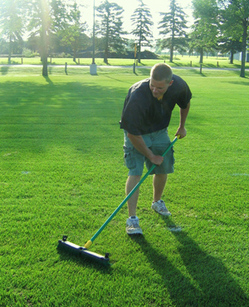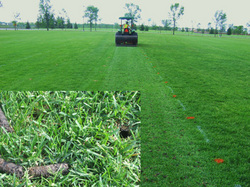Field work begins long before kick-off. Research by a university professor will determine the best mix for managing a quality athletic field with a smaller budget and crew - a serious  consideration in the current economy.
consideration in the current economy.
For Assistant Professor of Agronomy Kristie Walker, preparing a soil-based athletic field for both athletes and aesthetics on a budget is a delicate balance. Walker is spending her summer working on the football practice field at the University of Minnesota, Crookston where she teaches students in the agronomy and the golf and turf management programs.
Along with Mark Michalski, a senior double majoring in golf and turf management and horticulture, Walker is examining the effects of cultivation practices on three varieties of grass seed: Kentucky bluegrass , perennial ryegrass, and a mix of the two, all donated by Rivard's Quality Seeds Inc. in Argyle, Minn. The bluegrass, which spreads through rhizome production, germinates slowly but is the most aesthetically pleasing with its rich blue-green hue. The ryegrass, a bunch- type grass, has quicker germination but is less desirable in look and color.
"Football fields, like the one on the Crookston campus, are under a significant amount of traffic," Walker says. "With use by both the local high school and the university, we need a speedy recovery of the turf to be ready for play, but we also wanted the best looking field possible with a smaller staff and budget." This situation is common across the region in the parks and school districts with soil-based athletic fields under heavy use.
Best Mix of Seed, Practice, and Price
 Walker is testing hollow-tine and solid-tine cultivation methods along with verticutting on a variety of plots she has marked out for the study. The most disruptive, but probably the most beneficial to the soil, is the hollow-tine aeration which removes soil in cylindrical cores across the profile. The solid-tine aeration punches holes into the soil surface rather than removing cores. The least disruptive to the soil surface is the verticutter, which slices small furrows in the turf canopy and heals more quickly.
Walker is testing hollow-tine and solid-tine cultivation methods along with verticutting on a variety of plots she has marked out for the study. The most disruptive, but probably the most beneficial to the soil, is the hollow-tine aeration which removes soil in cylindrical cores across the profile. The solid-tine aeration punches holes into the soil surface rather than removing cores. The least disruptive to the soil surface is the verticutter, which slices small furrows in the turf canopy and heals more quickly.
Following the weekly cultivation, half of the plots are top-dressed, a method of spreading sand over the turf filling the cuts and holes so water can flow easily through the profile and compaction is reduced.
Measuring the outcome of the seed variety, cultivation technique, and the top dressing against the control will help determine the best method for maintaining football and soccer fields, as well as a baseball outfield. The research will take place over the next two years during the summer months and throughout the fall.
"We are looking for the best overall quality with consideration of cost," Walker says. "The best mix of cultivation practice and price will be the winning combination for us and for our athletic fields."
For more information on the golf and turf management program, visit www.umcrookston.edu/academics.
Today the University of Minnesota, Crookston delivers 29 bachelor's degree programs, 17 minors, and more than 40 concentrations, including several online degrees, in the areas of agriculture and natural resources; business; liberal arts and education; and math, science and technology. With an enrollment of about 1,300 undergraduates from more than 25 countries and 40 states, the Crookston campus offers a supportive, close-knit atmosphere that leads to a prestigious University of Minnesota degree. "Small Campus. Big Degree." To learn more, visit www.umcrookston.edu.
In the photos:
Top, right: Senior Mark Michalski, Silver Bay, Minn., spreads the top dressing as part of the research on the athletic field.
Bottom, left: The hollow-tine cultivation technique leaves cylindrical cores (inset) across the turf's profile.
 consideration in the current economy.
consideration in the current economy. For Assistant Professor of Agronomy Kristie Walker, preparing a soil-based athletic field for both athletes and aesthetics on a budget is a delicate balance. Walker is spending her summer working on the football practice field at the University of Minnesota, Crookston where she teaches students in the agronomy and the golf and turf management programs.
Along with Mark Michalski, a senior double majoring in golf and turf management and horticulture, Walker is examining the effects of cultivation practices on three varieties of grass seed: Kentucky bluegrass , perennial ryegrass, and a mix of the two, all donated by Rivard's Quality Seeds Inc. in Argyle, Minn. The bluegrass, which spreads through rhizome production, germinates slowly but is the most aesthetically pleasing with its rich blue-green hue. The ryegrass, a bunch- type grass, has quicker germination but is less desirable in look and color.
"Football fields, like the one on the Crookston campus, are under a significant amount of traffic," Walker says. "With use by both the local high school and the university, we need a speedy recovery of the turf to be ready for play, but we also wanted the best looking field possible with a smaller staff and budget." This situation is common across the region in the parks and school districts with soil-based athletic fields under heavy use.
Best Mix of Seed, Practice, and Price
 Walker is testing hollow-tine and solid-tine cultivation methods along with verticutting on a variety of plots she has marked out for the study. The most disruptive, but probably the most beneficial to the soil, is the hollow-tine aeration which removes soil in cylindrical cores across the profile. The solid-tine aeration punches holes into the soil surface rather than removing cores. The least disruptive to the soil surface is the verticutter, which slices small furrows in the turf canopy and heals more quickly.
Walker is testing hollow-tine and solid-tine cultivation methods along with verticutting on a variety of plots she has marked out for the study. The most disruptive, but probably the most beneficial to the soil, is the hollow-tine aeration which removes soil in cylindrical cores across the profile. The solid-tine aeration punches holes into the soil surface rather than removing cores. The least disruptive to the soil surface is the verticutter, which slices small furrows in the turf canopy and heals more quickly. Following the weekly cultivation, half of the plots are top-dressed, a method of spreading sand over the turf filling the cuts and holes so water can flow easily through the profile and compaction is reduced.
Measuring the outcome of the seed variety, cultivation technique, and the top dressing against the control will help determine the best method for maintaining football and soccer fields, as well as a baseball outfield. The research will take place over the next two years during the summer months and throughout the fall.
"We are looking for the best overall quality with consideration of cost," Walker says. "The best mix of cultivation practice and price will be the winning combination for us and for our athletic fields."
For more information on the golf and turf management program, visit www.umcrookston.edu/academics.
Today the University of Minnesota, Crookston delivers 29 bachelor's degree programs, 17 minors, and more than 40 concentrations, including several online degrees, in the areas of agriculture and natural resources; business; liberal arts and education; and math, science and technology. With an enrollment of about 1,300 undergraduates from more than 25 countries and 40 states, the Crookston campus offers a supportive, close-knit atmosphere that leads to a prestigious University of Minnesota degree. "Small Campus. Big Degree." To learn more, visit www.umcrookston.edu.
In the photos:
Top, right: Senior Mark Michalski, Silver Bay, Minn., spreads the top dressing as part of the research on the athletic field.
Bottom, left: The hollow-tine cultivation technique leaves cylindrical cores (inset) across the turf's profile.
Contact: Kristie Walker, assistant professor, agronomy, 218-281-8116 (kswalker@umn.edu); Elizabeth Tollefson, assistant director, communications, 218-281-8432 (ltollefs@umn.edu)

